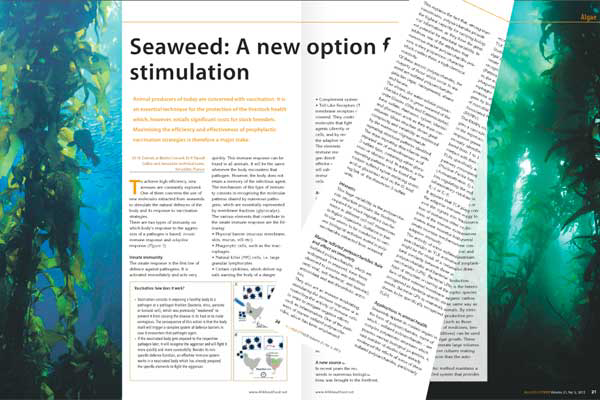AllAboutFeed 5th edition now online

In this new edition we highlight a few novel ingredients for feed. Cottonseed could be a good source of vegetable protein, but only ruminant animals can tolerate gossypol. Researchers at Texas A&M University have used RNAi technology to bioengineer cotton lines that exhibit ultra-low gossypol content in the seeds and normal levels elsewhere. Has the gossypol problem in cottonseed finally been solved?
Next, the benefits of algae are frequently discussed today. Algae are a diverse group of single organisms, with over 800,000 different species thought to exist with an estimated ability to produce over 15,000 novel compounds. While macroalgae dominates the global aquatic plant production, microalgae algae are currently being utilised in various nutritional products used in feed and foods due to the rich DHA omega-3 attributes. Another article describes interesting effects on immune stimulation – The use of new molecules extracted from seaweeds help the stimulation of the natural defences of the body and its response to vaccination strategies.
And yet, the edition features take home messages from the 4th Global Feed & Food Congress conference in April in South Africa. No speaker had any doubt that the industry will be able to feed a world population of 9.3 billion in 2050. Mario Sergio Cutait, chairman of the International Feed Industry Federation (IFIF), Dave Buchanan, leader of the World Trading Unit of Cargill or Hsin Huang, secretary-general of the International Meat Secretariat (IMF): all are sure the goal will be reached. They do however see more strings attached than just that number.
For Marty Matlock, professor at the University of Arkansas and program director in the Center for Agricultural and Rural Sustainability, it is quite simple. “Feeding almost 10 billion people without 1 hectare more land, 1 more litre fuel or 1 more drop of water is a challenge. It all comes down to management; improving feed, reducing manure, improving feed utilization, optimization of feed mixtures. That’ s the key. Intensification is critical: land, manure, diet management.”
Also during the conference, initiatives towards global guidelines of feed life cycle assessment and carbon footprint tool were presented. Driven by sustainability initiatives and concerns for CO2 emission in particular, livestock farms and feed producers are expected to show their measurements. However, the standards for life cycle assessment have been different among countries and there is an urgent need to create an internationally agreed approach. FEFAC and AFIA have now jointly come to a point to publish liaised guidelines.
Would you like to know what’s more in the edition, go and take a deeper look!











